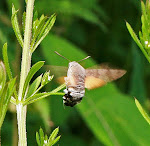Excellent hot dry weather over this period meant that many crickets and grasshoppers were active. Sometimes, in the hottest part of the day, grasshoppers especially could be seen in large numbers basking on the warm dry ground in scrub, on minor tracks or on road verges. Cyprus Orthoptera are difficult to identify as they comprise a large element of Middle Eastern species which are not covered by any available identification guide. Some of those seen are shown below.
Decticus albifrons, Anarita Park
Eupholidoptera cypria
Eupholidoptera cypria is another large bush-cricket which is also endemic to Cyprus. Again, it's very wary and hides in the vegetation when aproached.
Truxalis eximia subsp. cypria
This is part way between a grasshopper and a mantid. The subspecies is endemic to Cyprus although the nominate species is essentially Asiatic with Cyprus its western outpost. It occurs early in the season in various colour forms (as above). By contrast, the somewhat similar Acrida ungarica is found much later.
Acrotylus patruelis
This is a long-winged grasshopper with a rather characteristically-shaped pronotum and a barred pattern.
Oedipoda miniata, Polis
Very cryptically and variably coloured to provide camouflage in its sandy coastal habitat. When in flight the red-coloured wings can be seen.
Dociostaurus maroccanus (African Locust) at Kidasi, very frequent in Cyprus
Above: Pyrgomorpha cypria (male top) Polis; (female below) Kidasi
Chorthippus cypria-bornhalmi. Top photo: Akrotiri; lower photos: below the Asprokremnos dam
The two species are very difficult to separate. When mature they very often have bright red femora and abomen tips.
.jpg)
.jpg)
.jpg)
.jpg)
.jpg)
.jpg)
.jpg)
.jpg)
.jpg)
.jpg)
.jpg)
.jpg)
.jpg)
.jpg)






No comments:
Post a Comment